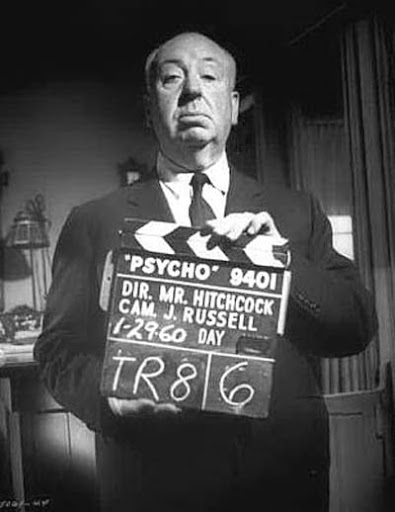The term film noir (French for "black film"), first applied to Hollywood movies by French critic Nino Frank in 1946, was unknown to most American film industry professionals of the era. Cinema historians and critics defined the canon of film noir in retrospect; many of those involved in the making of the classic noirs later professed to be unaware of having created a distinctive type of film.
What better way to start off a week of Noir films, than with the Master of Suspense himself. Alfred Hitchcock.
"There is no terror in a bang, only in the anticipation of it."
One of the most famous-- and possibly apocryphal-- Hitchcock anecdotes concerns a five-year-old Alfred Hitchcock, sent to the local police station with a note from his father after some mischief-making.After reading the note, a sergeant put young Alfred in a cell, and left him there for a few agonizing moments.The policeman returned and let Alfred go, only to tell him, "This is what we do to naughty boys." True or not, this story and Hitchcock's Roman Catholic background encompass all the themes Hitchcock would later put in his work-- terror inflicted upon the unknowing, and sometimes innocent victim; guilt (both real guilt and the appearance of it); fear, and redemption.
1960
This is the film that best epitomises how Hitchcock could mis-direct audiences and play games with them.Psycho (1960) is the "mother" of all modern horror suspense films - it single-handedly ushered in an era of inferior screen 'slashers' with blood-letting and graphic, shocking killings (e.g., Homicidal (1961), The Texas Chainsaw Massacre (1974), Halloween (1978), Motel Hell (1980), and DePalma's Dressed to Kill (1980) - with another transvestite killer and shower scene).
It is based on the novel of the same name by Robert Bloch, which was in turn inspired by the crimes of Wisconsin murderer Ed Gein. The film depicts the encounter between a secretary, Marion Crane (Janet Leigh), who is in hiding at a motel after embezzling from her employer, and the motel's owner, the lonely Norman Bates (Anthony Perkins).
SAUL BASS (1920-1996) was not only one of the great graphic designers of the mid-20th century but the undisputed master of film title design thanks to his collaborations with Alfred Hitchcock, Otto Preminger and Martin Scorsese. He is known for reinventing the movie title as an art form.
Haunting is the word to describe the vertical bars sweeping across the screen in a manic, mirrored helter-skelter motif at the beginning of Hitchcock’s 1960 Psycho. This staccato sequence is an inspired symbol of Norman Bates’ fractured psyche. Hitchcock also allowed Bass to work on the film itself, notably on its dramatic highpoint, the famous shower –murder scene with Janet Leigh.
TRIVIA
- The film only cost $800,000 to make yet has earned more than $40,000,000. Hitchcock used the crew from his TV series to save time and money. In 1962 exchanged the rights to the film and his TV-series for a huge block of MCA's stock (he became their third largest stockholder).
- Robert Bloch's original novel was inspired by the notorious serial killer Ed Gein who was also one of the inspirations for the character of Hannibal Lector (The Silence of the Lambs/Manhunter).
- Hitchcock bought the rights to the novel anonymously from Robert Bloch for just $9,000. He then bought up as many copies of the novel as he could to keep the ending a secret.
- The blood in the shower scene is actually chocolate sauce.
- The shot of Janet Leigh flushing the toilet is believed to be the first such shot in American cinema history.
- The MPAA refused to pass this film because they claimed to be able to see Janet Leigh's nipple during the shower scene. Hitchcock didn't edit it out, but merely sent it back, (correctly, it seems) assuming that they either wouldn't bother to watch it, or miss it the second time.
- Hitchcock insisted that audiences should only be allowed to see the film from the start so as not to ruin the surprise. This was unheard of back then as people were used to just coming in at any point during a movie.
- After the film's release Hitchcock received an angry letter from the father of a girl who refused to have a bath after seeing Diabolique and now refused to shower after seeing Psycho. Hitch sent a note back simply saying "Send her to the dry cleaners".


No comments:
Post a Comment